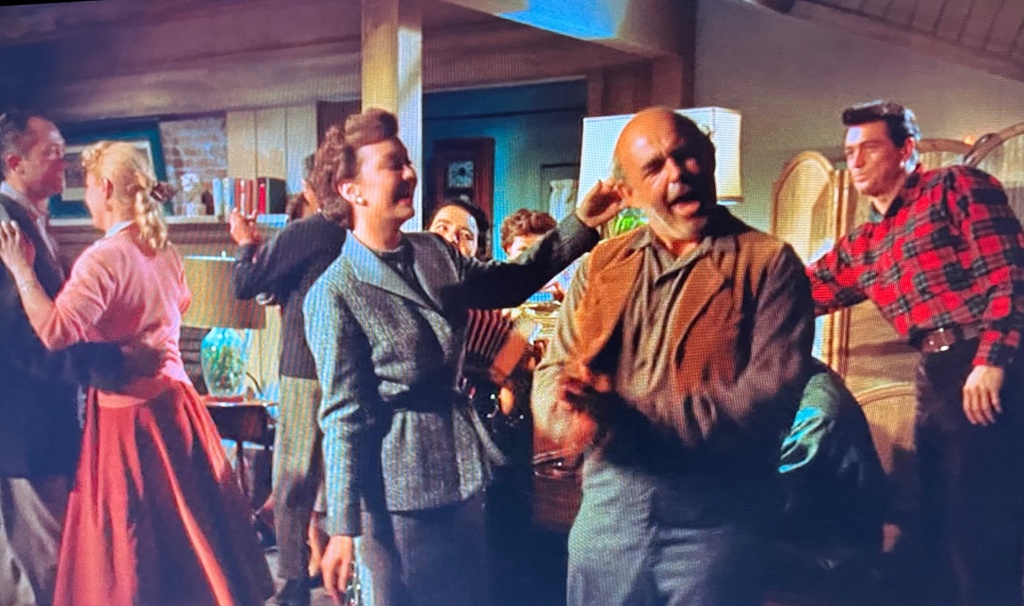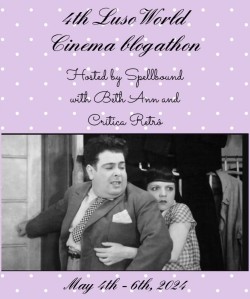He’s got a familiar face.
And notably bushy eyebrows under his balding hairline. He did the 5 o’clock shadow decades before it was fashionable. Then there’s the burly physique and a gregarious laugh that would sometimes come out of nowhere.
Nestor Paiva certainly had a screen presence, and it could loom large even in the smallest parts he played throughout his career that included around 400 film and television credits.
As Manuel the “lobster king” in the 1955 Technicolor weepie “All That Heaven Allows,” for example, Paiva is only in one scene that lasts about 4 minutes but you will remember it. As soon as he arrives with his lobsters to a dinner gathering of friends, he infuses the scene with undeniable joy through his infectious laugh and smile singing and dancing along with Jane Wyman and Rock Hudson. He’s the life of the party and you can’t help but smile watching him.

His film career started nearly 20 years before “All That Heaven Allows,” with uncredited roles in the 1937 movies “Island Captives” and “Blazing Barriers.” That phrase “uncredited” would be a constant in the first decade of his early career, yet Paiva never slowed down and in fact persevered whether he played an uncredited role, a bit part or a generic character like a guard (multiple films), conductor (“Union Pacific”), bartender (“Music for Millions,” “The Southerner”), bad-tempered gambler (“The Girl and the Gambler”), a man with suspenders (“Reap the Wild Wind”) and, one of my favorite descriptors, “man in street when gypsies arrive” (“The Hunchback of Notre Dame”).
Though he never reached leading-man status, moviegoers knew that familiar face and I, for one, still get a kick out of it whenever he pops up in a film I’m watching.
For that reason, I’m happy to share more about Nestor Paiva for the 2024 Luso World Cinema Blogathon which strives to raise the profile of Portuguese-speaking peoples and their descendants. The blogathon is co-hosted by talented writers Beth Ann Gallagher of Spellbound with Beth Ann and Brazilian film writer Letícia Magalhães of Critica Retro.
Paiva was of Portuguese heritage – his parents were natives of the Azores region of Portugal – and he was often cast in roles that drew on that heritage and utilized his gift for languages. In fact, if you’ve seen Paiva act, you may only have heard him speaking a foreign language or in a heavy accent as he played Spaniards, Italians, Greeks, Arabs and Russians. Here’s the surprise: he was born in California.
His father Francisco “Frank” Caetano Paiva, arrived in the U.S. at age 7 in 1880; his mother, Mariana Luísa (née Freitas) came in 1896 when she was 17. Nestor was born in 1905 in Fresno, Calif., where his dad owned a grocery store, and graduated from Fresno High School where he did some acting and was in Glee Club. The family moved to Northern California in 1929 where he attended the University of San Francisco, then the University of California Berkeley where he performed on stage both on and off campus, and even directed plays. After graduation, he would become director of the Eight o’Clock Players troupe at KLX radio in Oakland. At one point, he worked at Lockheed Aircraft during World War II but never gave up acting.
Many will recognize him from two notable roles: Spanish innkeeper Theo Gonzales on the Walt Disney series “Zorro” (and its film “The Sign of Zorro”) or as Captain Lucas in Universal’s “Creature from the Black Lagoon” and “Revenge of the Creature.”

At that time, he was beginning to earn roles substantial enough to be named in the opening credits and sometimes even right below the top two or three stars and deservedly so.
As a fan of 1950s sci-fi films, I fall in the latter category and love him in the two “Creature” films as well as the genre movies “Tarantula” (1955) and the underrated “The Mole People” (1956).
So while “Creature from the Black Lagoon” is known for Julie Adams, Richard Carlson and the wonderful creature, for example, it would have lacked its twinkle were it not for Paiva’s often oddly cheerful portrayal of the boat captain who had a childlike glee when he would sound the horn of his boat, The Rita.
A look at his credits
There’s certainly not enough space to run down all of Paiva’s credits, but an overview would help show the scope of his career. He played Burt Lancaster’s father in “Jim Thorpe: All American,” was in “Young Man With a Horn” with Kirk Douglas and starred with Roy Rogers in “Shine on Harvest Moon” and “Along the Navajo Trail.” He was in “Mighty Joe Young,” “Joan of Arc,” “April in Paris,” “Mr. Blandings Builds His Dream House,” “Oh, You Beautiful Doll,” “Phone Call from a Stranger,” “5 Fingers,” “I, the Jury” and “Viva Zapata!”

Paiva was ubiquitous on television Westerns of the 1950s and ‘60s including “Laramie,” “Wagon Train,” “Bonanza,” “The Virginian,” “Tales of Wells Fargo,” “Maverick,” “Cheyenne” and “Wanted Dead or Alive” – again the list is too long to mention here – and that doesn’t include television comedies or dramas like “Get Smart,” “Family Affair,” “The Addams Family,” “The Beverly Hillbillies” and “Perry Mason.” He also created multiple character voices over 26 episodes (1964-65) for the animated series “Johnny Quest.”
A favorite of TV role is how ably portrayed the dual characteristics of the title character in “The Whimsical Bandit” episode of “The Lone Ranger.” He was indeed quite whimsical as a Mexican thief with a love of birds, nature and “the beautiful women” who he would never rob without giving them something in return like his gaudy ring.
Don’t forget radio: He contributed to multiple episodes of “Tales of Texas Rangers” and the Bogart and Bacall adventure radio show “Bold Venture.”
Key roles
Want more Nestor Paiva? Here are a few films to check out.

Hope and Crosby connection
Paiva was in three of the Bob Hope-Bing Crosby “Road to…” films, plus was in Hope’s “The Paleface.” He was a full-bearded villain in oversized flannel outfit and hat in “Road to Utopia” (1945). He turned on the comic charm as club owner Cardosa in “Road to Rio” (1947) where his exuberance in working with traveling American musicians played Hope and Crosby was encapsulated in the scene where he tells them “Very good boys, very boys. Groovy, groovy,” after first hearing them play. It’s just fun.
“Lone Wolf in Mexico” (1947)
He played Inspector Carlos Rodriguez in a full uniform and a large smile, always happy to see his old pal Michael Lanyard – alias The Lone Wolf, a former jewel thief/now private detective – back in town – as long as he’s still retired. But when little things like murder start to happen, he implores Lanyard to “Tell Uncle Carlos everything. … Are you the mysterious killer, who shot the mysterious corpse?” He amusingly often talks to Lanyard almost like a child.

“Creature from the Black Lagoon” (1954)
Chomping on a cigar while wearing the same rumpled outfit through this great Universal sci-fi classic, Paiva lets out big grins while somehow keeping the cigar in his mouth. He’s the perfect escort for the research expedition looking into a fossilized link between humans and sea creatures, while also providing folklore that adds to the suspense. “Don’t forget our catfish – they grow to be 9 feet long – and killers,” he says with pride. But don’t underestimate him: He’s the one who provides key information on drugs the natives make with roots to help catch fish. Oh, and he just so happens to have some on his boat.
“Revenge of the Creature” (1955)
Now the captain of the Rita II, he’s taking two more travelers through the Amazon to see if the Gill-man is still alive. If he is, he tells, them “you’ll be sorry you found him.” His main role in the sequel is to tell these two men, who have no idea what they are in for, the story of the original expedition and what they discovered. All he needed was a campfire for it to sound like a ghost story. “My men call it the Black Lagoon … paradise. Only they say no one has ever come back to prove it,” he chuckles. The clothing he is wearing looks suspiciously like the same outfit he wore in the original film.

“Tarantula” (1955)
Paiva is a big part of this giant-bug film, one of the best in the genre, playing Jack Andrews, the sheriff in a small Arizona desert town who helps a doctor and researcher learn what is leaving a trail of bodies. As you can guess from the title, it’s a tarantula and one that grows to the size of a house from well-meaning experiments to end world hunger. In a cowboy hat and Western shirt, Paiva is uncharacteristically clean shaven and without an accent as he works to save the day alongside John Agar, who plays the handsome Dr. Matt Hastings, and the equally lovely Mara Corday as lab assistant Stephanie Clayton.

“Mole People” (1956)
In this inner-Earth sci-fi drama, Nestor plays Professor Etienne Lafare, who is working with archaeologists when they discover artifacts that point to a 500-year-old Sumerian civilization. He looks and sounds the part with a very heavy accent and wearing a pith (safari) helmet. Despite his better judgment, he joins the party traveling up a snowy mountain prone to avalanches to find the Sumerian civilization. They do, but as expected, it comes with unexpected results. Paiva surprisingly keeps up with younger and more fit companions, even rappelling 200 feet or so deep into a cavern, but the underground world of dark chambers and no sunlight will feed his anxiety and take a toll on his body.
“Comanche” (1956)
I’ve added this film because of its significance to Paiva’s family. He was married to Maxine Yvette Kurtzman in January 1941 until his death at only age 61 in 1966. They had a son and daughter, Joseph and Caetana, who appeared in a film for the first and only time here, as children killed by the Comanche. (An interesting choice.) Paiva played Puffer, a sidekick to Dana Andrews who tries to broker peace with the Comanche.

The blogathon
In celebration of World Portuguese Language Day on May 5, please read about other stars and filmmakers of Portuguese heritage through the Luso World Cinema blogathon.
It is co-hosted by Beth Ann Gallagher of Spellbound with Beth Ann and Letícia Magalhães of Critica Retro from May 4-6, 2024.
More from me
If you enjoy classic film creatures, read my monthly “Monsters & Matinees” column at Classic Movie Hub including:
A feature on actress Mara Corday
Meeting “The Ghost of Sierra de Cobra”
All bug-eyed over big-bug movies
Revisiting the shades of fear in “The Leopard Man”


Great piece, Toni. I love Nestor in Creature From The Black Lagoon but need to see more his work. Thanks for telling me more about the man himself.
Maddy
LikeLike
Maddy,
Thanks for reading and sorry for the delayed response. I clearly remember a time when I would see Nestor Paiva on screen and, though I didn’t know his name, his appearance made me think I would love what was to come. I was happy that writing the story allowed me to learn more about him.
Toni
LikeLiked by 1 person
Toni, thanks so much for writing about Nestor Paiva! Despite passing too young, he had an amazingly long career and so many credits. I knew you’d highlight his horror films, and you did a great job of highlighting other performances and genres. There’s a genuine affection for him that comes through in your piece. Love it!
Finding time to finish my own piece last weekend, I fell behind in my host duties, but I’m catching up on them between now and Sunday. I’ll update my master post (the announcement), promote posts more on socials, and write a blogathon wrap-up. All will include this excellent piece.
Thanks again for fitting in the time to write for the blogathon and shine the light on this essential character actor’s career!
LikeLike
Hi Beth Ann,
Sorry for the delay in responding – I was going to email you and for some unknown reason, didn’t do it. I was happy to write the story. I learned so much about a man whose face I was always happy to see in a movie but for so long, I barely knew his name. He had an amazing career that I would not have learned about without your suggestion. Thank you.
Toni
LikeLike
Thank you so much for this contribution to the blogathon! I’m sure I’ve seen Nestor Paiva before, but never associated the name to the (more than 400 – wow!) role. I’ll keep my eyes wide open for him the next time I watch a classic movie or TV show.
Best,
Le
LikeLike